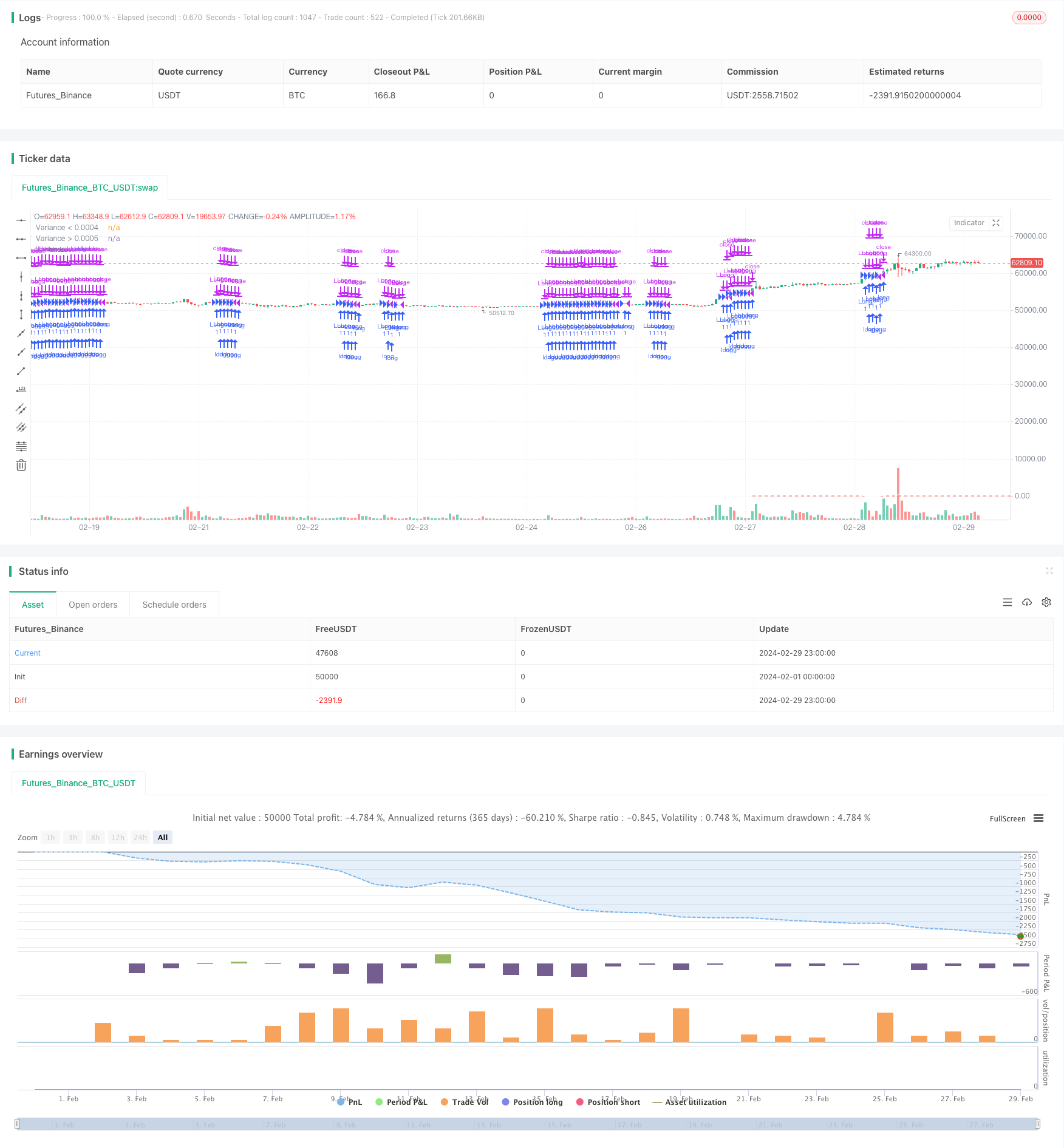
该策略名为”基于方差和移动平均线的波动幅度策略”,它利用过去30根K线的波动幅度方差和三条移动平均线(MA5、MA15和MA30)来制定交易决策。
策略的主要思想是通过计算价格波动幅度的方差来衡量市场的波动性,并结合不同周期的移动平均线来判断趋势方向。当波动性较低且短期均线在长期均线之上时,策略会进行买入操作。同时,策略设置了止损和止盈条件来控制风险和锁定利润。
策略的原理可以分为以下几个步骤: 1. 计算5日、15日和30日移动平均线(MA5、MA15和MA30)。 2. 计算过去30根K线的波动幅度(最高价和最低价之差除以收盘价)的方差,并将其乘以1,000,000以便于观察。 3. 定义买入条件:方差小于35且MA5大于MA15,MA15大于MA30。 4. 定义止损条件:收盘价低于MA30或MA5低于MA30。 5. 定义止盈条件:方差大于500。 6. 当买入条件满足时,策略开仓做多;当止损或止盈条件满足时,策略平仓。
该策略的优势包括: 1. 结合波动性和趋势指标,能够在趋势明确且波动性较低时进行交易,避免了在波动剧烈的市场环境下交易。 2. 使用多个周期的移动平均线,能够更全面地判断趋势方向,提高交易的准确性。 3. 设置明确的止损和止盈条件,有效控制风险和锁定利润。
策略的风险主要有: 1. 在市场趋势不明确或波动性突然增大时,策略可能会出现频繁交易或错误信号。 2. 止损和止盈条件的设置可能无法完全适应所有市场环境,需要根据实际情况进行调整。 3. 策略依赖于历史数据,对于突发事件或市场异常波动可能反应不及时。
为了优化该策略,可以考虑以下几个方向: 1. 对于买入条件中的方差阈值和移动平均线组合,可以通过回测和参数优化来寻找最佳值。 2. 止损和止盈条件可以引入更多技术指标或市场情绪指标,如RSI、MACD等,以提高信号的可靠性。 3. 可以考虑引入市场风险管理机制,如动态调整仓位、波动率调整等,以应对市场环境的变化。
总的来说,“基于方差和移动平均线的波动幅度策略”是一个结合波动性和趋势指标的交易策略。它通过计算价格波动幅度的方差来衡量市场的波动性,并结合不同周期的移动平均线来判断趋势方向,在适当的市场环境下进行交易。该策略设置了明确的止损和止盈条件,能够有效控制风险和锁定利润。同时,策略还有优化的空间,可以通过参数优化、引入更多指标和风险管理机制来提高其适应性和稳健性。
/*backtest
start: 2024-02-01 00:00:00
end: 2024-02-29 23:59:59
period: 1h
basePeriod: 15m
exchanges: [{"eid":"Futures_Binance","currency":"BTC_USDT"}]
*/
//@version=5
strategy("Variance and Moving Averages Strategy", overlay=true)
// 计算MA5、MA15和MA30
ma5 = ta.sma(close, 5)
ma15 = ta.sma(close, 15)
ma30 = ta.sma(close, 30)
// 计算过去30根K线的波动幅度(最高价和最低价)的方差
variance = ta.variance((high - low) / close, 30) * 1000000
// 定义买入条件
buy_condition = variance < 35 and ma5 > ma15 and ma15 > ma30
// 定义止损条件 close < ma30 or ma5 < ma30
stop_loss_condition = true
// 定义止盈条件
take_profit_condition = variance > 500
// 执行交易逻辑
if (buy_condition)
strategy.entry("Long", strategy.long)
if (stop_loss_condition)
strategy.close("Long")
if (take_profit_condition)
strategy.close("Long")
// 绘制MA5、MA15和MA30
// plot(ma5, color=color.blue, title="MA5")
// plot(ma15, color=color.orange, title="MA15")
// plot(ma30, color=color.red, title="MA30")
// 绘制方差
hline(0.0004, color=color.green, linestyle=hline.style_dashed, title="Variance < 0.0004")
hline(0.0005, color=color.red, linestyle=hline.style_dashed, title="Variance > 0.0005")
plot(variance, color=color.white, title="Variance")